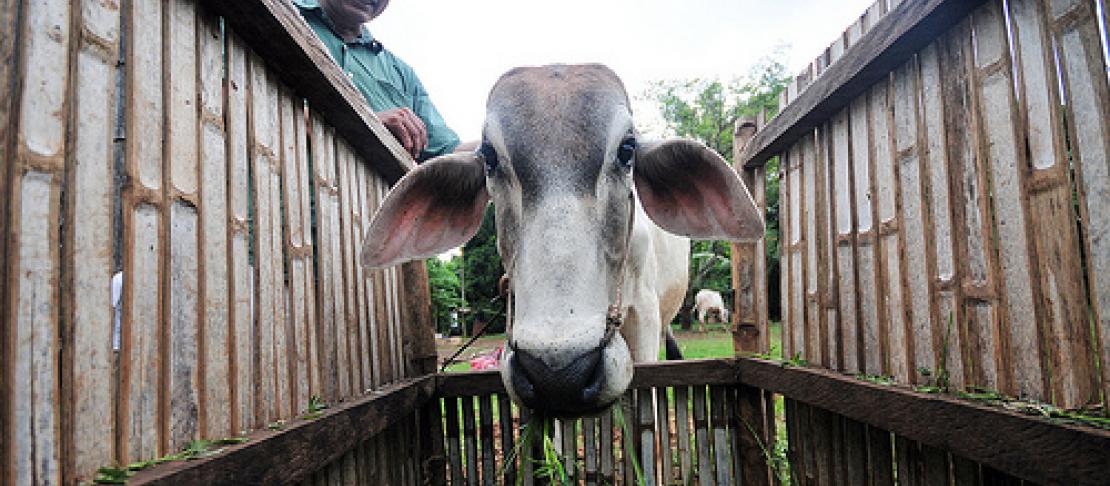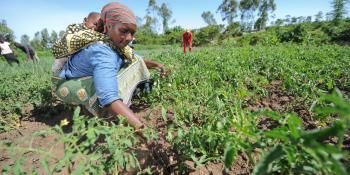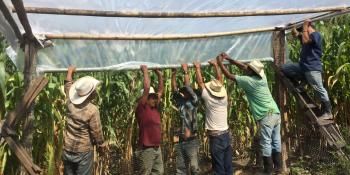Reducing carbon hoofprints and increasing tropical farming incomes

Simple production changes could benefit farmers and the environment, says Philip Thornton.
Livestock enterprises contribute substantially to the world’s greenhouse gases, largely through deforestation to make room for livestock grazing and feed crops, the methane ruminant animals give off, and the nitrous oxide emitted by manure. Estimates of this contribution vary widely (10-18% (PDF), or more, of global greenhouse-gas emissions) and are still being researched – it’s a complex question and hotly debated.
Whatever the exact figure, many worry these greenhouse-gas emissions will only grow due to increasing livestock production to meet the surging demand for meat and milk in developing countries.
But significant livestock-related greenhouse gas reductions could be quickly achieved in tropical countries by modifying production practices, which were recently detailed in a paper by myself and a colleague published in the Proceedings of the National Academy of Sciences. For example, switching to more nutritious pasture grasses, supplementing diets with even small amounts of crop residues or grains, restoring degraded grazing lands, planting trees that both trap carbon and produce leaves that cows can eat, and adopting more productive breeds can all be employed relatively quickly to reduce emissions.
Such changes could increase the amount of milk and meat produced by individual animals, thus reducing emissions because farmers would require fewer animals.
For example, in Latin America switching cows from natural grasslands to more nutritious sown pastures can increase daily milk production and weight gain by a factor of three. Fewer animals would then be needed to satisfy demand, while farmers’ incomes could be raised substantially.
There are several other well-documented options that could increase incomes for smallholders while at the same time reducing overall emissions.
Supplementing grazing with feed consisting of crop residues, such as the leaves and stalks of sorghum or maize plants, is one example. There is also potential to boost production per animal by crossbreeding local with genetically improved breeds, so providing more milk and meat than traditional breeds while emitting less methane per kilo of meat or milk produced. Supplementing cattle diets with the leaves of certain trees, such as Leucaena leucocephala, has similar effects on meat and milk production and incomes.
These options could not only reduce methane emissions, but some of them, such as planting improved pastures and agroforestry tree species, can also sequester carbon directly. For example, if about 30 percent of livestock owners in the tropical regions of Latin America switch from natural grass to improved grasses such as some of the Brachiaria species, this alone could reduce carbon dioxide emissions by about 30 million tons per year.
Payback time
It would be a useful incentive if these farmers were allowed to sell the reductions they achieve as credits on global carbon markets. Overall, at US$20 per ton, which is roughly what carbon is currently trading for on the European Climate Exchange, we calculate that poor livestock keepers in tropical countries could generate about US$1.3 billion each year in carbon revenues. Such carbon payments could make a meaningful contribution to many livestock-keeping households.
My colleague and I have calculated that, for a range of readily-available options for poor livestock keepers to increase production in the tropics, these could save about 7 percent of all livestock-related global greenhouse-gas emissions (a conservative estimate, as we did not consider the full range of options available to livestock keepers, nor did we consider nitrous oxide emissions). Consumption of milk and meat may double in the developing world by 2050, so it’s critical to adopt sustainable approaches now that reduce the negative effects of increasing livestock production while allowing countries to realize the benefits, such as better nutrition and higher incomes for livestock-producing households.
At the same time, reductions in the consumption of livestock products in developed countries could result in additional and substantial reductions in emissions.
But back in the tropics, many livestock keepers are highly dependent on their animals for food, for income, as ‘engines’ to prepare their land, and as tradable assets. They need technological options and economic incentives that help them intensify their production in sustainable ways. Hence, carbon payments would be a welcome additional incentive that could help to bring about useful and much-needed changes in smallholder livestock production as well as bringing about a more conducive enabling environment.
About Philip Thornton
Philip Thornton is a Theme Leader and Senior Scientist with the Programme on Climate Change, Agriculture and Food Security (CCAFS) at the International Livestock Research Institute (ILRI) in Nairobi, Kenya, and an Honorary Research Fellow in the Institute of Atmospheric and Environmental Sciences at the University of Edinburgh. He has worked mostly in Latin America, Europe, North America and Africa, on systems modelling and impact assessment. His current research interests revolve around integrated assessment at different scales and evaluating the possible impacts of global change on agricultural systems in developing countries.


